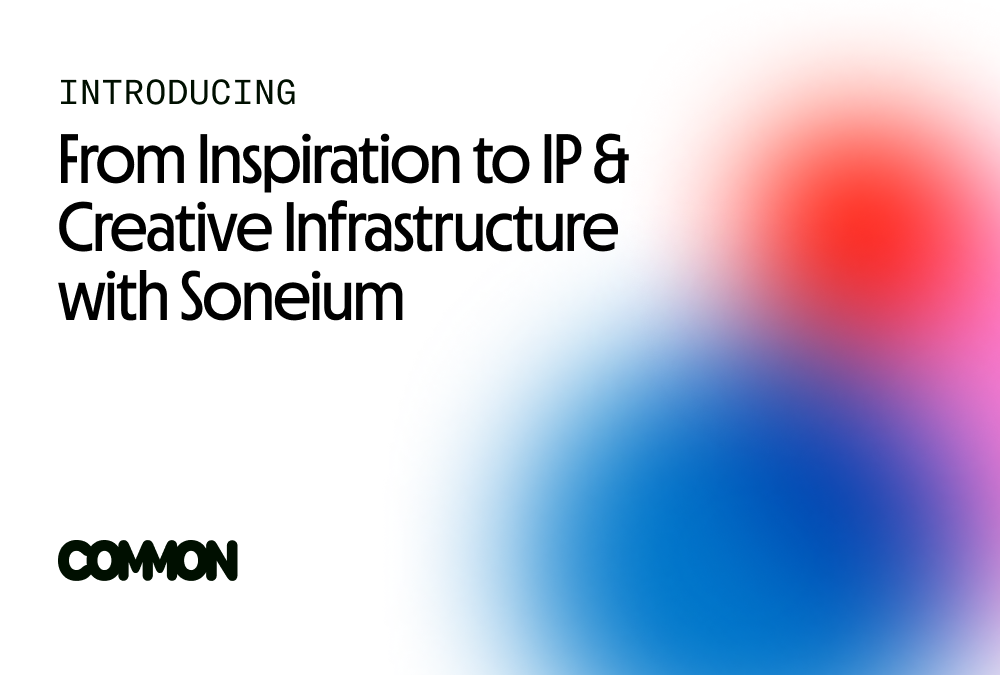From Inspiration to IP and Creative Infrastructure with Soneium

Creative innovation in the Soneium ecosystem
The future of creative IP and infra lies in blockchain tech, restoring ownership to creators. Recently, we held a panel discussion where the Soneium ecosystem chatted about the evolution of creative IP in web3, the empowerment of artists onchain, and the infrastructure needed to support digital culture.
Here are some of the highlights from the conversation!
Creative IP onchain: ownership, value, and transparency
At its core, creative IP onchain introduces new concepts of ownership and value exchange. As Jerad from Startale explained, blockchain represents the next evolution in how we share ideas:
"The first one would be ownership, which I think all of us know. Now we have the idea of ownership. I can share something with you and you can share it with me, but now I can also exchange some sort of value with you."
This ownership layer transforms creative expression by providing transparent, immutable records of creation, allowing artists to prove provenance while enabling communities to build upon shared creative assets.
Dillon highlighted how this enables "remixing" of creative assets, referencing projects like Loot from 2021, where simple text NFTs representing RPG character traits spawned entire ecosystems of interoperable projects. This is one example of how onchain assets can become building blocks for broader creative ecosystems.
Bridging physical and digital art
LiveArt's approach shows how real-world assets (RWAs) can be brought onchain. The company recently launched a fractionalized product on Soneium featuring work by renowned artist Yayoi Kusama, allowing broader access to previously exclusive fine art.
Luisa explained their unique approach:
"We are selling fractionalized assets and providing a digital experience of a physical collectible that has very strict IP protections to it. For us, the focus is on this ownership collectible experience where you buy a fraction of a real-world art that has been verified by us."
LiveArt enriches this experience by creating exclusive digital collectibles that owners receive alongside their fractional ownership. For the Kusama piece, they designed a character that fractional owners can collect, creating a bridge between traditional art collecting and digital ownership.
Traditional vs. digital approaches to artist communities
The relationship between artists and their communities differs significantly between digital-native creators and traditional artists entering crypto. LiveArt has observed two distinct approaches:
- Digital artists often come with established communities, requiring careful navigation to ensure new web3 initiatives align with community expectations.
- Traditional artists, even famous ones, typically need help building onchain communities from scratch. This involves providing context about the artist's career, market value, and significance for community growth.
The panel noted that this community-owned approach brings more access and transparency to art collecting, allowing smaller creators to showcase their work alongside world-renowned artists in ways previously impossible.
Meme economy
Beyond traditional art, the panel discussed how "lowbrow" creative expressions like memes are finding value onchain. These assets provide accessible entry points for new users to experience blockchain ownership.
Jerad explained:
"Memes can be very powerful because they're an easy way to build culture... They can be really fun because there's a lot of launch platforms on Soneium that allow you to experiment with bringing something onchain."
The panel acknowledged that while not everything needs to be onchain, sectors like gaming, music, and anime show significant potential for blockchain integration due to their digital-native nature. Meanwhile, fields like architecture or engineering might maintain stronger off-chain components.
The Sake bottle experiment
Sake Finance explained how DeFi protocols can integrate creative elements to enhance user experience. Their "sake bottle" concept uses free NFTs as an onboarding mechanism:
"Sake is a bottle concept. In the real world, a bottle of sake is actually very expensive. On the NFT aspect, it's actually free," explained Mojo. "On a weekly basis, users come on board to our platform. They get to spin these sake bottles, and then they get some form of points."
This gamified approach helps new users explore DeFi functionalities while building community. The bottles, designed by an in-house artist, create a sense of ownership and belonging, where creative assets can function as pathways into more complex blockchain interactions.
Financial primitives for creative assets
The intersection of DeFi and creative IP opens even more possibilities. The panel discussed several financial models for creative assets:
- Fractionalization: Breaking ownership of high-value assets into smaller, tradable units
- NFT-collateralized lending: Using creative assets as collateral for loans
- Vote-directed rewards: Using VE tokenomics to direct emissions to cultural assets
Kyo Finance described how their vote-escrowed system could support creative assets:
"If one creator builds a fractionalized art and makes an NFT or art into an ERC20 token and wants to incentivize that directly... they could create a gauge of that like a staking vault and vote on that vault and it'll get emission."
This approach could potentially solve challenges around royalties and creator rewards by directing protocol fees based on the length of ownership or staking activity.
The AI frontier in creative IP
SONEX highlighted how AI can enhance DeFi and creative experiences onchain:
"AI is used as a complementary or supportive tool for users... Where you can have various use case specific AI agents that help users either swap more efficiently, trade better, provide alpha, etc."
Beyond trading, AI could help users navigate the complex worlds of art collection, offering guidance on history, value, and creative context.
Infra challenges for the creative economy
The panel identified several infrastructure gaps that still need addressing for creative web3 ecosystems to flourish:
- User experience: Simplified onboarding remains the biggest challenge. As Mojo noted, "The UI/UX is still not the best. We have all the approving transactions etc. We are definitely working on things."
- Account abstraction: Jerad highlighted the need for better solutions to private key management, as expecting users to securely store seed phrases creates friction and security risks.
- Community infra: Dillon emphasized the need for better social infrastructure to help users learn, connect, and interact with the ecosystem.
Democratized creative markets & creator sustainability
As these technologies mature and infrastructure challenges are addressed, we're likely to see increasingly fluid interactions between physical and digital creative assets, with broader participation from both creators and collectors.
The vision emerging from this panel suggests a future where blockchain technology democratizes access to creative markets while introducing new models for creator sustainability.

